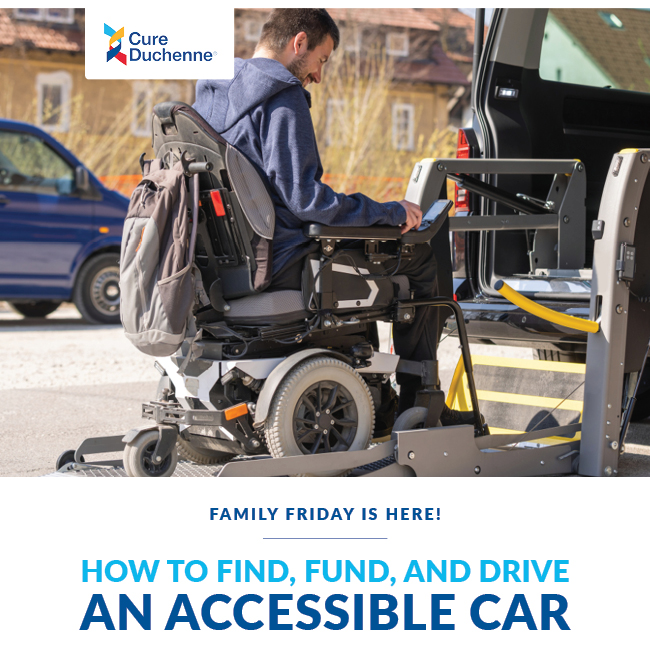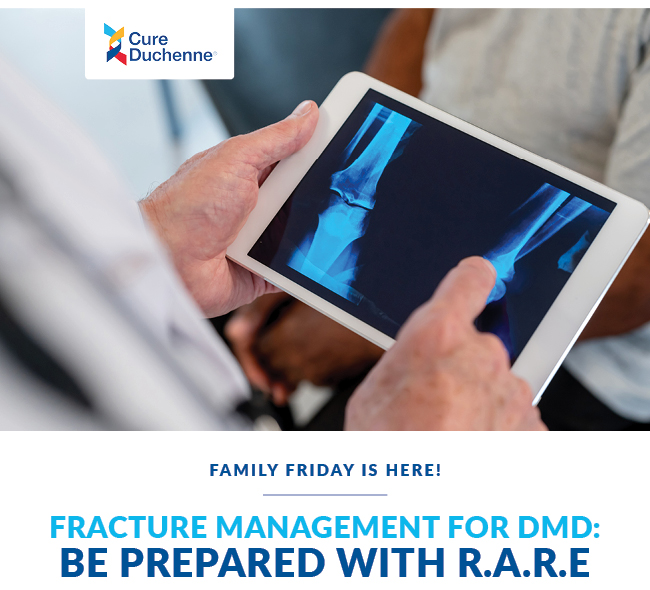Managing Femur Fractures in Duchenne Muscular Dystrophy

By Jennifer Wallace, PT and Doug Levine, PT
Introduction
Duchenne muscular dystrophy (DMD) is a neuromuscular disorder that affects an estimated 1 in 5,000 live male births and is largely characterized by progressive muscle weakness. DMD itself, and even some of the current medical treatments, present challenges beyond muscle weakness. One that we have recently taken an in-depth look at is the risk of bone fractures. Among these, femur fractures are of particular concern due to their potential to cause someone to lose their ability to walk. The CureDuchenne physical therapy team worked with Dr. Rachel M. Thompson, MD and Dr. Christopher R. Gajewski, MD both from the orthopedic departments at UCLA to publish a case series that explores the outcomes of operative versus nonoperative management of femur fractures in patients with DMD and the importance of physical therapy in the outcomes.
Bone Health in DMD
Some of the primary bone health factors people with DMD face are limited weight-bearing and the use of glucocorticoids. The combination of these two factors reduces bone mineral density. This heightened risk of osteopenia and osteoporosis makes fractures, particularly in the lower extremities, more prevalent.
Treatment Options
Historically, nonoperative treatment with casting has been the primary choice for managing long bone fractures in DMD patients. However, this method has caused many issues including loss of strength and joint flexibility from immobilization and carries a high risk of malunion and pressure ulcers. In contrast, operative interventions, such as intramedullary nailing, have gained popularity among surgeons caring for these patients. These surgeries reduce immobilization time, malunion rates, and permit early mobilization.
The Case Series: Surgical vs. Nonoperative Management
This case series looked at DMD patients treated for femur fractures between 2013-2022 at UCLA. The study included 10 patients with 11 femur fractures. Five fractures underwent operative fixation (Group A), while six fractures were managed nonoperatively (Group B).
Group A patients experienced displaced femur fractures. Surgical intervention using locked intramedullary nails was successful in restoring the baseline ambulatory status for the three who were ambulatory at the time of the fracture, with no adverse events reported.
In Group B, nonoperative management was preferred for non-ambulatory patients and those with minimally displaced fractures including one ambulatory patient. While all fractures healed successfully, the one patient in this group who was ambulatory did not regain the ability to walk.
Physical Therapy: A Crucial Component
Regardless of the chosen treatment modality, all patients received physical therapy as soon as possible to preserve strength, muscle mass, and range of motion. Early initiation of physical therapy is essential to prevent joint stiffness which causes contractures, and to deter disuse muscle atrophy, which together can limit functional mobility. In this study and from multiple personal experiences with our own patients who have DMD, we have seen the tides turn. Whereas many patients used to lose their ability to walk after a femur fracture, we see many more regain ambulation with proper management.
Conclusion
Managing femur fractures in patients with DMD requires a multidisciplinary approach tailored to each patient’s unique circumstances. Nonoperative management remains a viable option for non-ambulatory patients and those with minimally displaced fractures. However, surgical intervention is recommended for higher-functioning patients with the goal of restoring ambulatory status. This study and our own experiences highlight the importance of early physical therapy to maintain and restore function post-fracture. This case series provides some insights, but further research is needed to establish optimal treatment protocols based on fracture location and ambulatory status in DMD patients.
For more information, please read the full Case Series: https://jposna.org/index.php/jposna/article/view/664/799
For insight in to one young man’s personal experience of overcoming a femur fracture with DMD: https://cureduchenne.org/blog/hawkens-perspective-overcoming-a-fractured-femur-with-duchenne/




